PONTIAC GRAND-PRIX 1993 User Guide
Manufacturer: PONTIAC, Model Year: 1993, Model line: GRAND-PRIX, Model: PONTIAC GRAND-PRIX 1993Pages: 338, PDF Size: 17.3 MB
Page 11 of 338
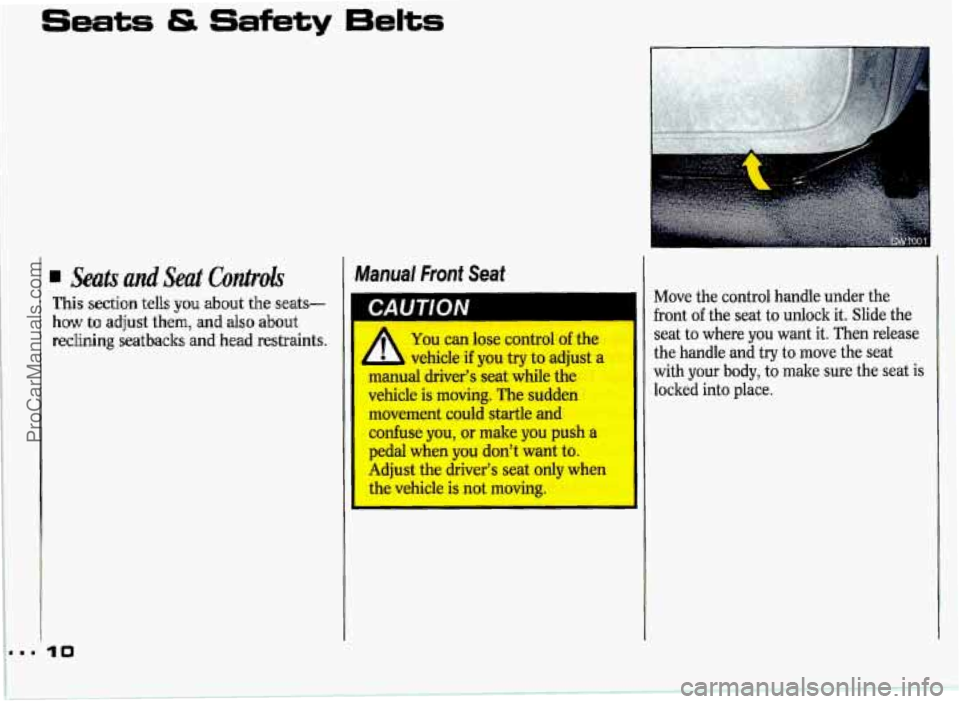
Seats & Safety 6eIts
Se& ad Seat Cuntrok
This section tells you about the seats-
how
to adjust them, and also about
reclining seatbaclrs and head restraints.
Manual Front Seat
I bnu I lUlV
You can lose control of the
2 L vehicle if you try to adjust a
manual driver’s seat while the
vehicle is moving. The sudden
movement could startle and
confuse you, or make
you push a
pedal when you don’t want to.
Adjust the driver’s seat
only when
the vehicle is not moving.
Move the control handle under the
front
of the seat to unlock it. Slide the
seat
to where you want it. Then release
the
handle and try to move the seat
with your
body, fo make sure the seat is
locked into place.
ProCarManuals.com
Page 12 of 338
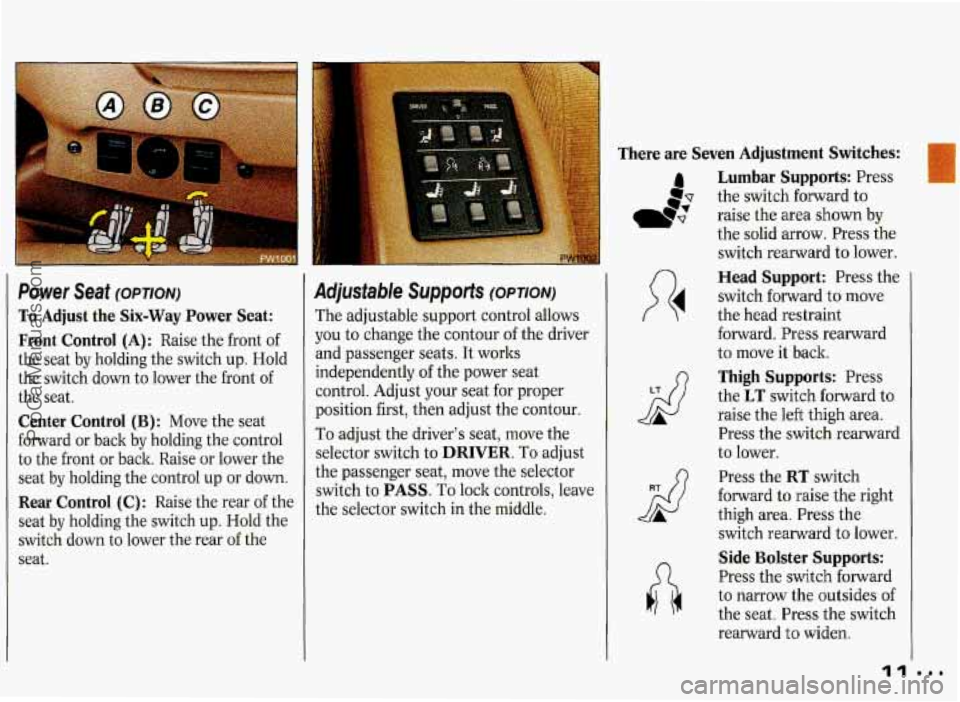
There are Seven Adjustment Switches:
Power Seat (OPTION)
To Adjust the Six-Way Power Seat:
Front Control
(A): Raise the front of
the seat by holding the switch up. Hold
the switch down to lower the front of
the seat.
Center Control (B): Move the seat
forward or back by holding the control
to the front or back. Raise or lower the
seat by holding the control up or down.
Rear Control (C) : Raise the rear of the
seat by holding the switch up. Hold the
switch down to lower the rear of the
seat.
Adjustable Supports (OPTION)
The adjustable support control allows
you to change the contour
of the driver
and passenger seats. It works
independently of the power seat
control. Adjust your seat for proper
position first, then adjust the contour.
To adjust the driver’s seat, move the
selector switch to
DRIVER. To adjust
the passenger seat, move the selector
switch to
PASS. To lock controls, leave
the selector switch in the middle.
d
Lumbar Supports: Press
the switch forward to
raise the area shown by
the solid arrow. Press the
switch rearward to lower.
Head Support: Press the
switch forward to move
the head restraint
forward. Press rearward
to move it back.
Thigh Supports: Press
the
LT switch forward to
raise the left thigh area.
Press the switch rearward
to lower.
Press the
RT switch
forward to raise the right
thigh area. Press the
switch rearward to lower.
Side Bolster Supports:
Press the switch forward
to narrow the outsides of
the seat. Press the switch
rearward
to widen.
11
ProCarManuals.com
Page 13 of 338
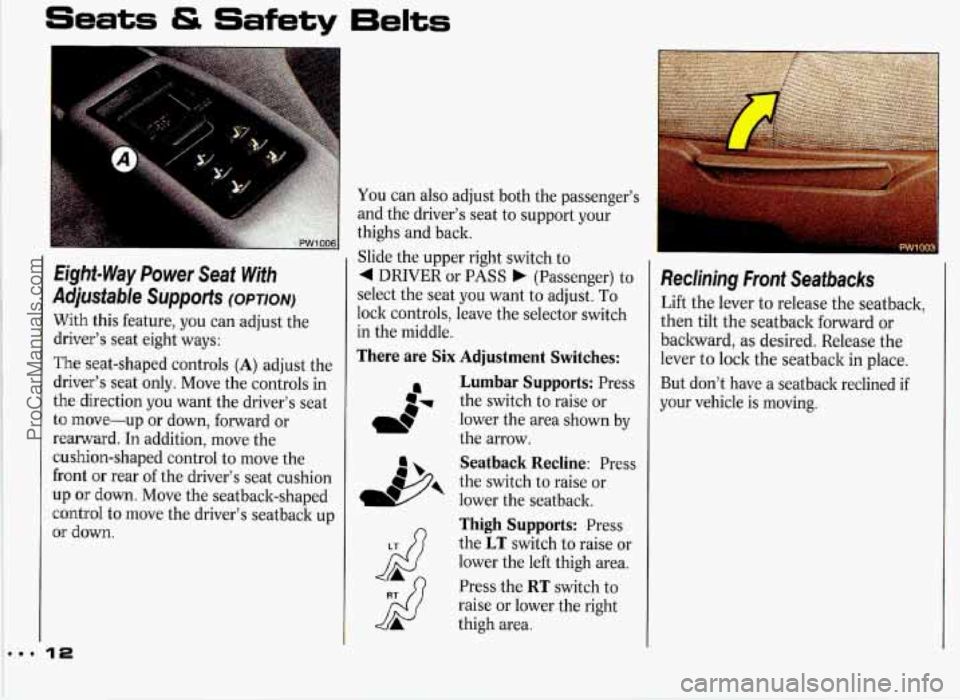
Eight-Way Power Seat With
Adjustable Supports (OPTION)
With this feature, you can adjust the
driver’s seat eight ways:
The seat-shaped controls
(A) adjust the
driver’s seat only. Move the controls in
the direction you want the driver’s seat
to move-up or down, forward or
rearward. In addition, move the
cushion-shaped control to move the
front or rear of the driver’s seat cushion
up or down. Move the seatback-shaped
control to move the driver’s seatback
up
or down.
You can also adjust both the passenger’s I
and the driver’s seat to support your
thighs and back.
Slide the upper right switch to
4 DRIVER or PASS b (Passenger) to
select the seat you want to adjust,
TO
lock controls, leave the selector switch
in the middle.
There are Six Adjustment Switches:
Lumbar Supports:
Press
the switch to raise or
lower the area shown
by
the arrow.
Seatback Recline: Press
the switch to raise or
lower the seatback.
Thigh Supports: Press
the
LT switch to raise or
lower the left thigh area.
Press the
RT switch to
raise
or lower the right
thigh area.
Reclining Front Seatbacks
Lift the lever to release the seatback,
then
tilt the seatback forward or
backward,
as desired. Release the
lever to lock the seatback
in place.
But don’t have a seatback reclined if
your vehicle
is moving.
ProCarManuals.com
Page 14 of 338
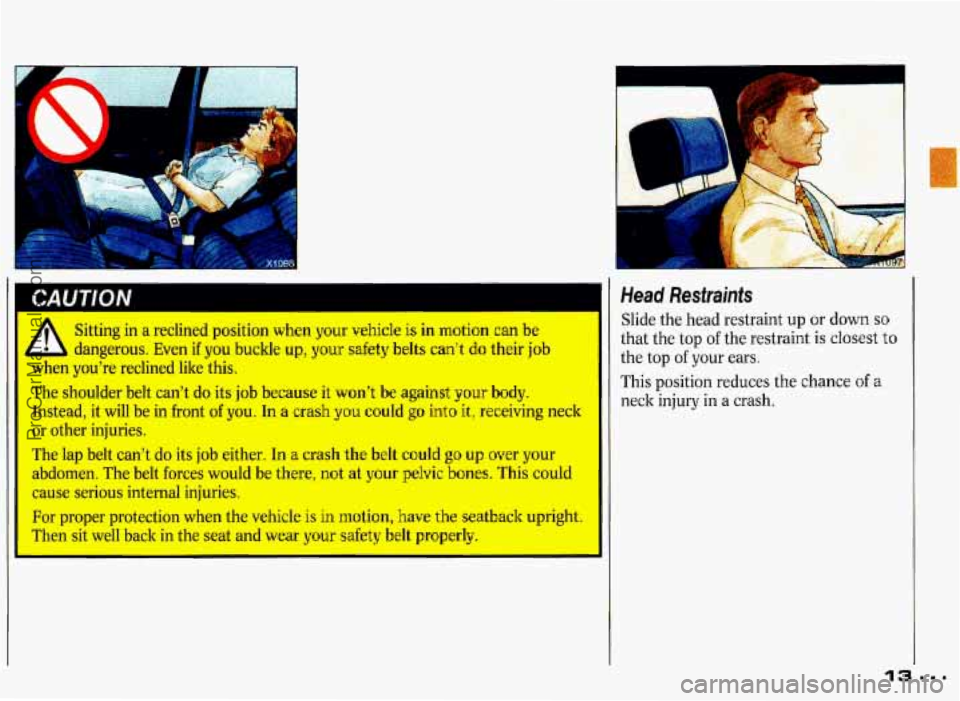
P
CAUTION
Sitting in a reclined position when your vehicle is in mation can be
L dangerous. Even if you buckle up, your safety belts can’t do their job
mllGn you’re reclined like this.
The shoulder belt can’t do its job because it won’t be against ~LU- body.
Instead, it will be in front of you. In a crash you could go into it, receiving neck
or other injuries.
The lap belt can’t do its job either. In a crash the belt could go up over your
abdomen. The belt forces would be there, not at your pelvic bones. This could
cause serious internal injuries.
For proper protection when the
vehicle is in motion, have the seatback upright.
Then sit well back in the seat and wear your safety belt properly.
n
t
b L. .
Head Restraints
Slide the head restraint up or down so
that the top of the restraint is closest to
the top
of your ears.
This position reduces the chance of a
neck injury in a crash.
ProCarManuals.com
Page 15 of 338
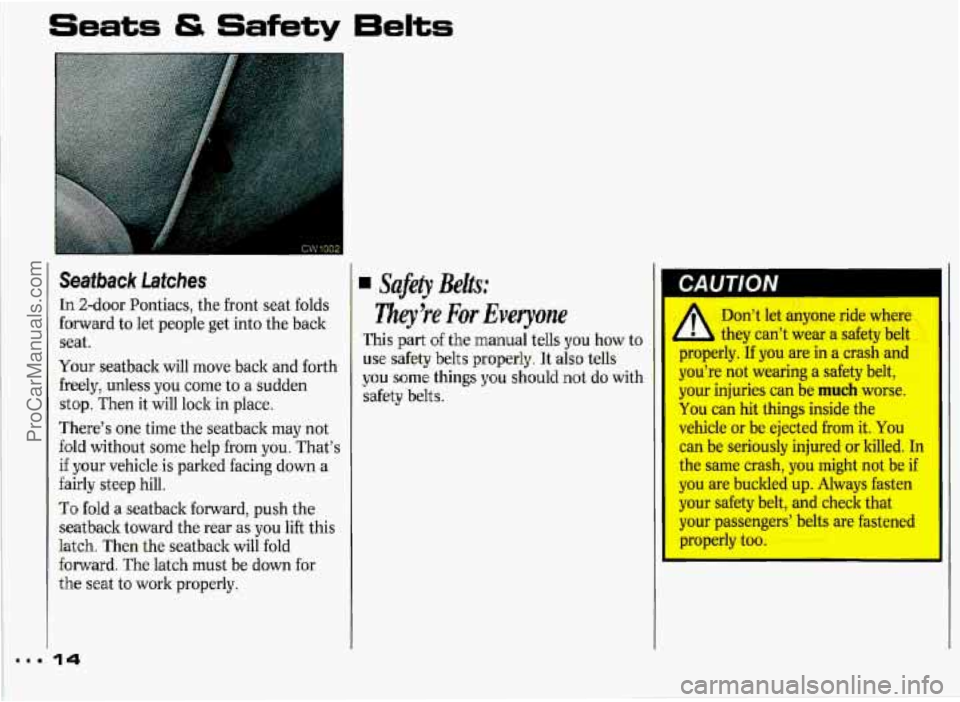
Seats & Safety Eelts
I’
Seatback Latches
In 2-door Pontiacs, the front seat folds
forward to let people get into the back
seat.
Your seatback will move back and forth
freely, unless you come to a sudden
stop. Then it will lock in place.
There’s one time the seatback may not
fold without some help from
you. That’s
if your vehicle is parked facing down a
fairly steep hill.
TQ fold a seatback forward, push the
seatback toward the rear as you
lift this
latch. Then the seatback will fold
forward. The latch must be down for
the seat to work properly.
4 Safety Belts:
They’ve For Everyone
This part of the manual tells you how to
use sakty belts properly. It also tells
you mme things you should not do with
s’afety belts .
14
Don’t let anyone ride where I L
- they can’t wear a safety belt
properly.
If you are in a crash and
you’re not wearing a safety belt,
your injuries can be
much worse.
You can hit things inside the
vehicle or be ejected from it.
You
can be seriously injured or killed. In
the same crash, you might not be
if
you are buckled up. Always fasten
your safety belt, and check that
your passengers’ belts are fastened
properly too.
ProCarManuals.com
Page 16 of 338
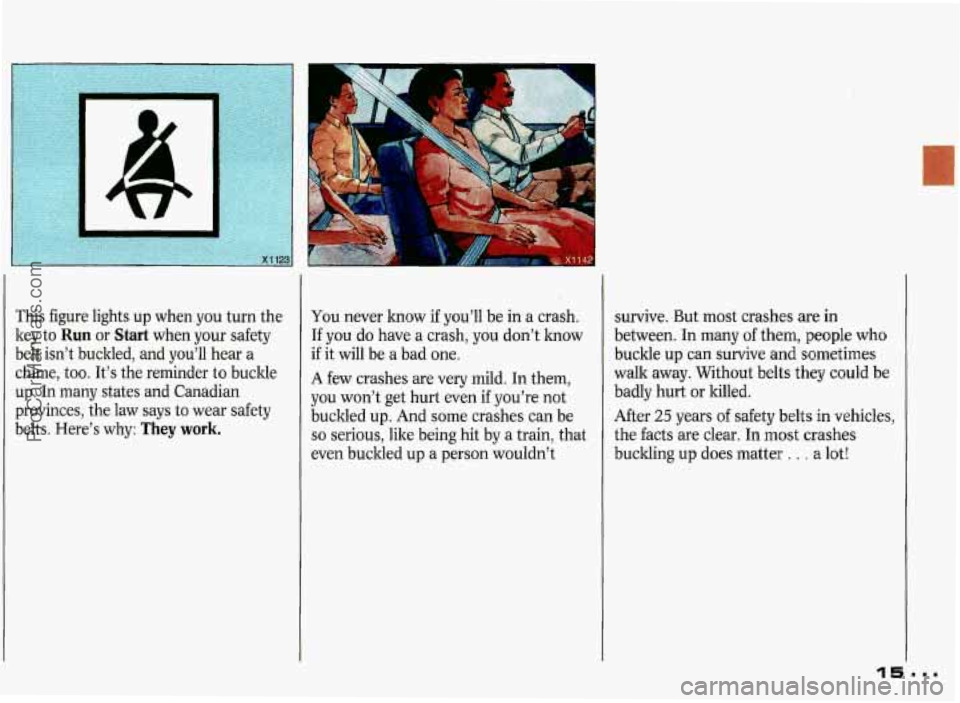
This figure lights up when you turn the
key to
Run or Start when your safety
belt isn’t buckled, and you’ll hear a
chime, too. It’s the reminder to buckle
up.
In many states and Canadian
provinces, the law says to wear safety
belts. Here’s why:
They work.
You never know if you’ll be in a crash.
If you do have a crash, you don’t know
if it will be a bad one.
A few crashes are very mild. In them,
you won’t get hurt even if you’re not
buckled
up. And some crashes can be
so serious, like being hit by a train, that
even buckled
up a person wouldn’t survive. But
most crashes are in
between. In many
of them, people who
buckle up can survive and sometimes
walk away. Without belts they could
be
badly hurt or killed.
After
25 years of safety belts in vehicles,
the facts are clear.
In most crashes
buckling
up does matter . . . a lot!
ProCarManuals.com
Page 17 of 338
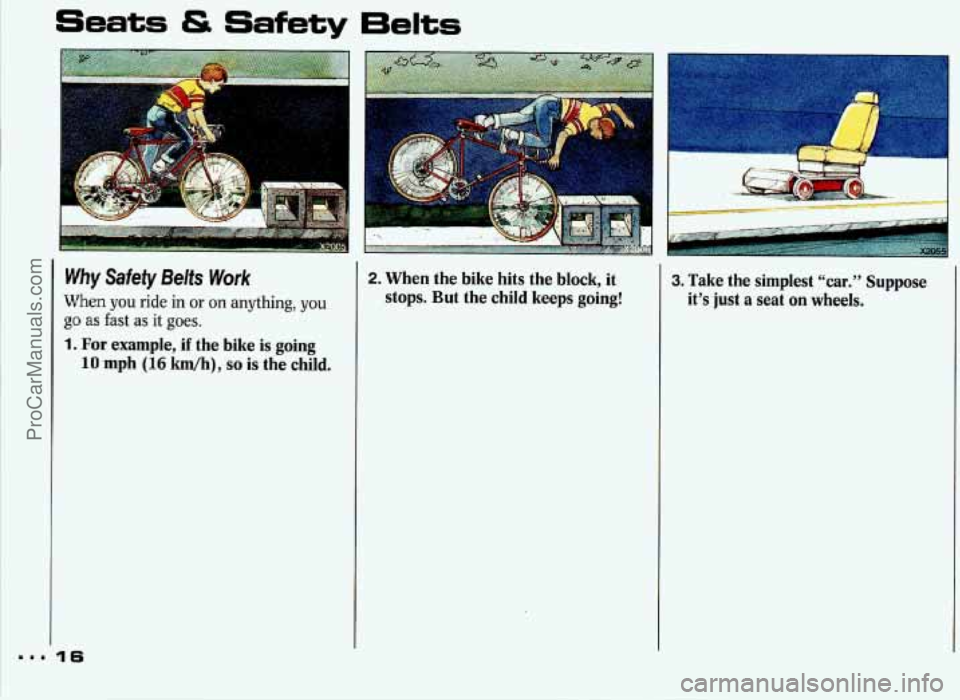
Seats & Safety 6elts
Why Safety Belts Work
When you ride in or on anything, you
1. For example, if the bike is going
as fast as it goes.
10 mph (16 km/h), so is the child.
2. When the bike hits the block, it
stops. But the child keeps going! 3. Take the simplest “car.” Suppose
it’s just a seat on wheels.
ProCarManuals.com
Page 18 of 338
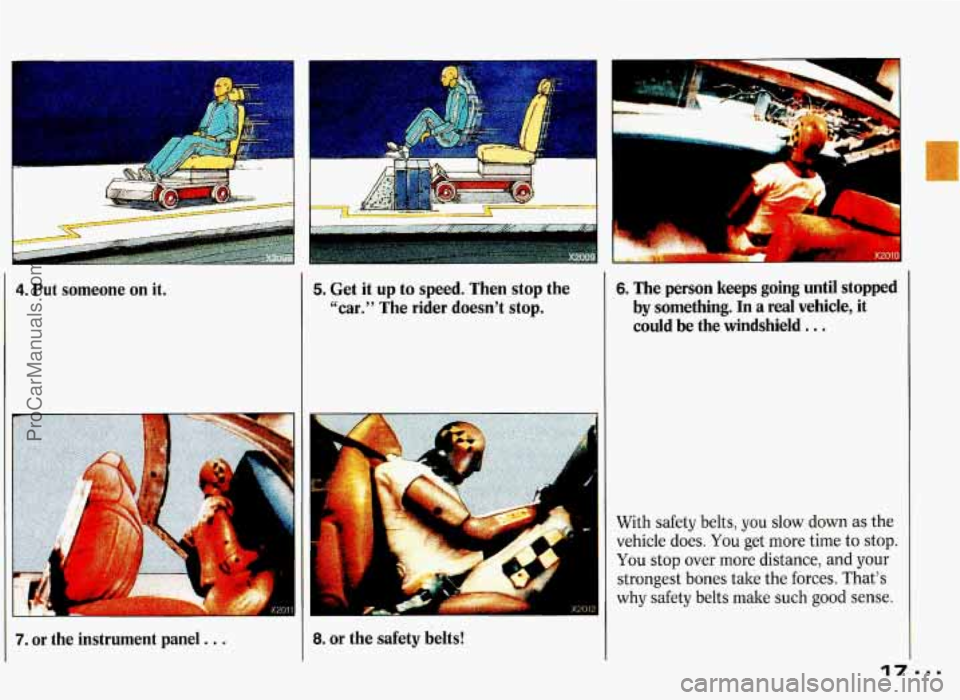
4. Put someone on it.
1r I
7. or the instrument panel . . .
5. Get it up to speed. Then stop the
“car.” The rider doesn’t stop.
I 8. or the safety belts!
x2012
6. The person keeps going until stopped
by something. In a real vehicle, it
could be the windshield.
. .
With safety belts, you slow down as the
vehicle does. You get more time to stop.
You stop over more distance, and your
strongest bones take the forces. That’s
why safety belts make such good sense.
ProCarManuals.com
Page 19 of 338
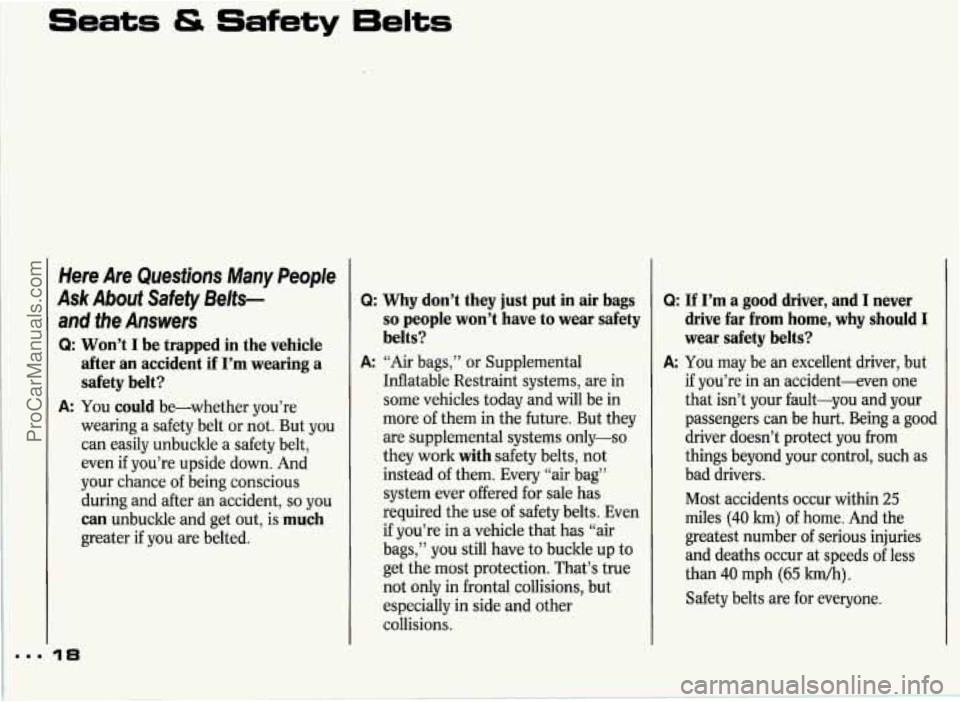
Seats 4S Safety 6eIts
Here Are Questions Many People
Ask About Safety 8elts-
and the Answers
Q: Won’t I be trapped in the vehicle
after an accident if I’m wearing a safety belt?
wearing a safety belt or not. But you
can easily unbuckle a safety belt,
even if you’re upside down. And
your chance of being conscious
during and after an accident,
so you
can unbuckle and get out, is much
greater if you are belted.
A: You could be-whether you’re
18
Q: Why don’t they just put in air bags
so people won’t have to wear safety
belts?
Inflatable Restraint systems, are in
some vehicles today and will be in
more
of them in the future. But they
are supplemental systems only-so
they work
with safety belts, not
instead
of them. Every “air bag”
system ever offered for sale has
required the use of safety belts. Even
if you’re in
a vehicle that has “air
bags,” you still have
to buckle up to
get the most protection. That’s true
not only in frontal collisions, but
especially in side and other
collisions.
A: “Air bags,” or Supplemental
Q: If I’m a good mver, and I never
drive
far from home, why should I
wear safety belts?
A: You may be an excellent driver, but
if you’re in an accident-even one
that isn’t your fault-you and your
passengers can be hurt. Being
a good
driver doesn’t protect
you from
things beyond your control, such as
bad drivers.
Most accidents occur within
25
miles (40 km) of home. And the
greatest number
of serious injuries
and deaths occur at speeds of less
than
40 mph (65 W).
Safety belts are for everyone.
ProCarManuals.com
Page 20 of 338
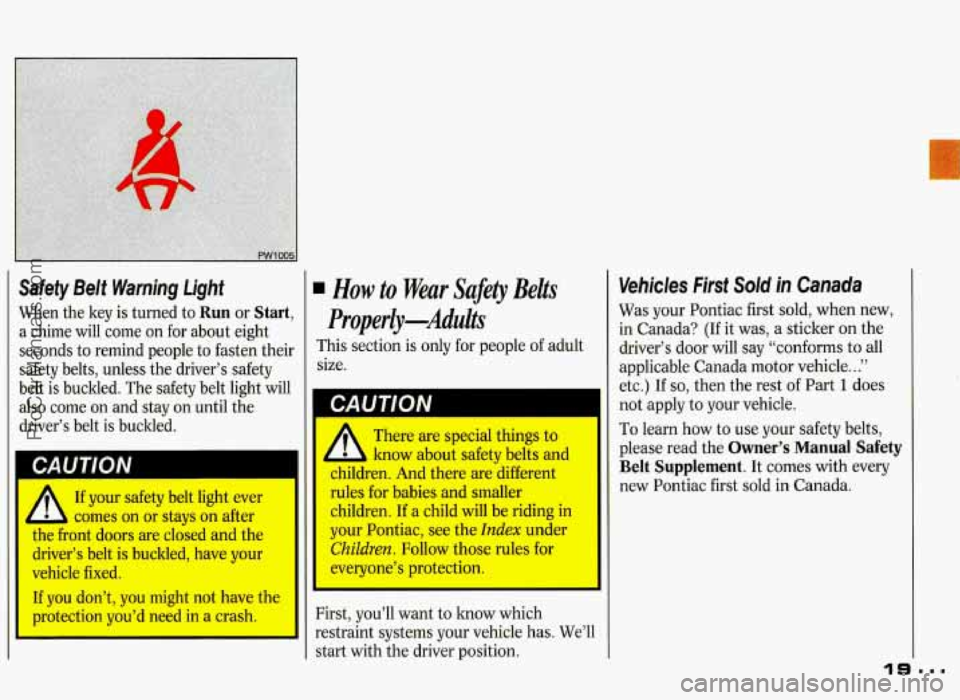
Safefy Belt Warning Light
When the key is turned to Run or Start,
a chime will come on for about eight
seconds to remind people
to fasten their
safety belts,
unless the driver‘s safety
belt
is buckled. The safety belt light will
also come on and stay on until the
driver’s belt is buckled.
CAUTION
If your safety belt light ever
tllc iont doors are closed and the
driver’s belt is buckled, have your
vehicle fixed.
If you don’t, you might not have the
protection you’d need in a crash.
h comes on or stays on after
This s6ction is only for people of adult
size.
I CAUTION
* There are special things to
2 know about safety belts and
children. And there are different
rules for babies and smaller
children.
If a child will be riding in
your Pontiac, see the
Index under
ChiZdren. Follow those rules for
everyone’s protection.
First, you’ll want
to how which
restraint
systems your vehicle has. We’ll
I start with the driver position.
Vehicles; Firsf SoEd in Canada
Was your Pontiac first sold, when new,
in Canada? (If it was, a sticker on the
driver’s door will say “conforms to all
applicable Canada motor vehicle.. .”
etc.) If so, then the rest of Part 1 does
not apply ta your vehicle.
To learn how to use your safety belts,
please read the Owner’s Manual Safety
Belt Supplement. It comes with every
new Pontiac first sold in Canada.
ProCarManuals.com